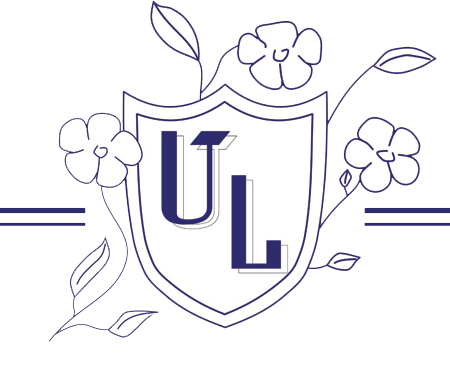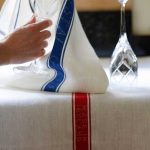Irish linen The Old Bleach Linen Co., Ltd .• Randalstolwn, Northern Ireland.Part One
Linen history can be told in parallel to human civilization’s history. It is one of the earliest products known of civilization. When man was in his primitive state, subsisting on the wild animals trapped in the chase, the skins of the animals he caught formed his only clothing. Later, when nomadic communities formed, driving their herds of cattle across the plains of eastern Europe during the great migrations the wool from the flocks of sheep was used to clothe their masters.
After a long period man settled down, built himself cities, and tilled and cultivated the land. Amongst the products of the soil was flax, out of the: fiber of which linen was made. Linen is, therefore, the earliest vegetable fabric to be woven.
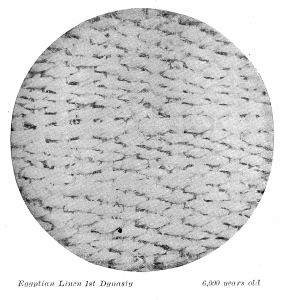
Egyptian Linen 1st Dynasty
Historical
Through the ages linen history has persisted. The romance of its history is closely interwoven with the Bible stories. When Jehovah wished to smite the Egyptians, who held His chosen people in subjection, one of the plagues which descended upon the fertile Valley of the Nile destroyed the crops, and we read that “the flax and the barley was smitten, for the barley was in the ear and the flax was boiled.” The word “boiled” is used in the North of Ireland today, and means that the seed capsule has formed. Linen has always been held in reverence as an emblem of purity, and frequent mention of it occurs throughout the Old Testament.
Whilst the children of Israel were wandering in the desert, and had strayed far from the paths that Moses had laid down, ensnared in the worship of the Golden Calf, it became necessary to lead their feet once again back to the Tabernacle.
The description of the Tabernacle, which formed the central point of worship for the tribes of Israel, tells us that the curtains were of fine linen, and when Aaron, the high priest, entered the holy place, he put on a holy linen coat and girdle, and upon his head was a linen Mitre. This shows the unique place held by linen in the history of ancient times, and the reverence accorded it is further demonstrated in the New Testament, which states that when the Revelation of things to come was vouchsafed to St. John, the seven angels, who held in their hands the past and future of mankind, were clothed in pure and white linen; and a final quotation from the same Book of Revelations informs us that the garments of those chosen for eternal life and happiness will be of fine linen. This, naturally, is the members of the linen trade!
The use of linen for priestly vestments was not confined to the Israelites, but from Plutarch, who lived and wrote one hundred years after the birth of Christ, we know that also the priests of Isis wore linen because of its purity.
Antiquity of Linen History
When the tomb of the Pharaoh of the Exodus, Rameses II., who died 1258 B.C.-3,000 years ago-was discovered in 1881, the linen wrappings were in a state of perfect preservation.
In the Belfast Library there is preserved the mummy of “Kaboolie,” the daughter of a priest of Ammon, who died 2,500 years ago. The linen on this mummy is in a like state of perfection. The present research in Egypt has resulted in many and wonderful discoveries, and it is a matter of historical verity that when the tomb of Tutankamen was opened, the linen curtains were found intact whereas all other fabrics crumbled into dust.
In the British Museum, London, are pieces of mummy-linen 6,000 years old. Recently cuttings from these were microscopically examined and photographed (as illustrated) at the Linen Industry Research Institute, Belfast, and were found to be as structurally perfect ,as linen made today. This bears out in every particular the contention we make of its invincible resistance to the march of time. This is also important from the hygienic point of view, for there can be no doubt that harmful germs leave linen severely alone, otherwise in these cases, the linen would long ago have turned to dust.
Earliest Linen Industry
In olden days of linen history, in almost every country, each family grew flax and wove the linen for its own use; but the earliest records of an established linen industry are 4,000 years old, and come to us from Egypt.
The Phoenicians, who, with their merchant fleet, opened up new channels of commerce to the peoples of the Mediterranean, besides developing the tin mines of Cornwall, introduced flax growing and the making of linen into Ireland before the birth of Christ, but the internal dissensions, which even in those early days were prevalent in Erin, militated against the establishment of an organized industry, and it is not until the twelfth century that we can find records of a definite attempt to systematize flax production.
When the Edict of Nantes was revoked, in A.D. 1695, many of the Huguenots who had to flee the country settled in the British Isles, and amongst them was Louis Crommelin, who was born, and brought up as a weaver of fine linen, in the town of Cambrai. He fled to Ulster, and eventually settled down in the small town of Lisburn, about ten miles from Belfast.
During the late war Cambrai became well known as one of the centers of the most desperate fighting. Tille name “cambric” is derived from this town.
Although the linen industry was already established in Ulster, Louis Crommelin found scope for improvement in weaving, and his efforts were so successful that he was appointed by the Government to develop the industry over a much wider range than the small confines of Lisburn and its surroundings. The direct result of his good work was the establishment, under statute, of the Board of Trustees of the Linen Manufacturers of Ireland in the year 1711.
Part Two
The Board of Trustees of the Linen Manufacturers for over 100 years (1711 to 1823) fostered and controlled the Irish Linen Industry. and it was due to the marked success of its control that Irish Linens today are looked upon as the high mark in quality among the linen manufactures of the world. This Board of Trustees was composed of eighty members, twenty representatives from each of the four provinces, among them the most exalted and distinguished men of the day. They had under them a most efficient organization, which carried out its duties with a skill and energy much to be admired, and which took a firm hold of the whole situation through the medium of seal masters, or inspectors, placed in convenient centers all over Ireland. Marking a significant impact on linen history, resulting in Ireland as the standard of quality.
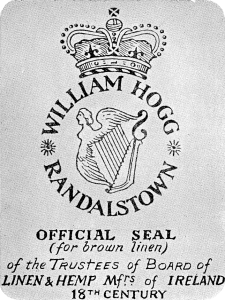
The Seal Masters
Every activity of the Linen Industry was directly under the control of these seal masters. The flax seed could not be sown until it had been inspected. and the seal of the seal master affixed to the bag.
Spinning and weaving were to a great extent carried out by the peasants in their cottages, ancestors of those’ weavers now working in our modern factories, and the latter’s hereditary aptitude, combined with the experience of generations, is an important factor in maintaining the high standard of today. Before the woven linen could be sold to the merchant it had to be submitted to the “Brown Seal Master,” who, if it came up to the standard of quality required, affixed his seal, and the merchant was at liberty to purchase and send it on to be bleached; but, again, before he could export. the merchant had to submit the linen to the “White Seal Master” at the port of shipping, so that it might undergo a final inspection.
Thus Irish Linen was held rigorously to a high standard, and it is not surprising that it established a lasting name for quality and reliability.
By the year 1741. just thirty years after the establishment of the Linen Board, the Irish linen industry had increased almost one hundred times, and it was found that the merchants had become so thoroughly imbued with the advantage to them of maintaining quality that, in the case of those who had established a reputation for standard excellence, permission was granted them to affix their own white seal in their own warehouses, this seal being issued by the Board.
In 1823 the Board of Trustees of the Linen Manufacturers of Ireland came to an end. as it was considered that the industry was then sufficiently on its feet to require no further outside assistance.
From the disbandment of the Board of Trustees until the outbreak of the Great War in 1914 the Irish Linen trade experienced a steady growth, and ever-increasing exports to all parts of the world shows clearly the dominance gained by strict adherence to quality rules of production.
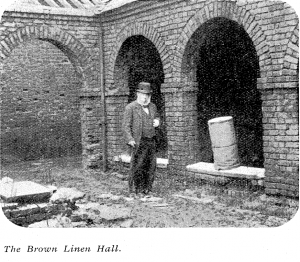
The Brown Linen Hall
Linen Associations
The conclusion of the war marked in linen history as the completion of the movement to organize the Irish Linen Industry which had been initiated some years earlier.
Each section had its Association. all these individual Associations co-operating on matters of common importance. The underlying idea was an orderly, self-governing industry promoting fair trading. constructive development and legislating within itself against the abuses which are inevitable under conditions of destructive as opposed to constructive competition.
This conception was due to the genius and vision of the late Sir Alexander McDowell. K.B.E., a prominent Belfast lawyer, closely connected with the Industry. Chiefly as a result of his untimely “death about the end of the war, the effectiveness of the Associations, under the strain of the postwar deflation. unfortunately broke down.
Strange to say, this development while unsuccessful in the Irish Linen Industry, was to some extent the inspiration and the model from which the now famous codes of the N.R.A. in the United States of America were evolved.
This happened in the usual unexpected way. A campaign of publicity in the U.S.A. on Irish linen was planned to start at the conclusion of the war and the carrying out of this campaign was entrusted to the late Mr. A. C. Pearson of the United Publishers Corporation, New York, who was also Chairman of the Association which in Washington looked after the interests of the Trade Press of America.
During his visits to Belfast Mr. Pearson became much interested in the Organization of the Irish Linen Industry and when in 1921 ex-President Hoover became Secretary of Commerce under the Harding administration, he, on the Press side. Co-operated with Mr. Hoover in initiating a somewhat similar movement in American Industry generally.
This movement took root and spread, the Industries taking it up becoming known as “Hooverised Industries.” As a result. in 1933. when Mr. Roosevelt became President and initiated the “New Deal” he found ready to his hand in the Department of Commerce, the expert staff and the experience which made it possible to codify compulsorily the whole of American Industry.
It is now recognized that the N.R.A. Codes. in spite of all the criticism they evoked and the fact that the Supreme Court has outlawed them. have proved to be one of the most practical and beneficial parts of the New Deal, for they reestablish wages and the price structure on an economic basis.
Irish Linen Society
Two Associations of an uplift rather than of an executive nature-The Irish Linen Society and The Linen Industry Research, are worthy of special mention in linen history. The Irish Linen Society was formed to carry out publicity on Irish Linen, and the Linen Industry Research Association to promote its scientific development. The Irish Linen Society collapsed in the depression of 1921, but the seed had been sown and later there arose phoenix-like from its ashes, the Irish and Scottish Linen Damask Guild in New York. From that time until 1932 when the recent depression rendered a curtailing of its activities essential, that organization, which also took under its wing linens generally. carried out under Mr. Alfred Brown, its director, highly constructive propaganda and publicity on linen to the benefit not only of the Industry but also of its customers.
Amongst its activities were promotions on table decoration in the larger stores throughout the U.S.A. and Canada. Three hostess lecturers were employed on this work, which had a marked effect on display in linen departments generally and was a considerable factor in re-establishing the use of the damask tablecloth in that country.
As a result of the success of the Damask Guild in the U.S.A. the Irish Linen Guild was in 1928 organized to operate in the Home Market under the direction of Mr. John Gilliland. This was on a somewhat smaller scale but has carried on successfully up to the present time.
Nearly all the activities of the Guilds both at home and in America have been in cooperation with the retail linen departments, and in spite of inevitable criticisms of detail, incidental to any movement of this description, their assistance has met with general appreciation.
What is to the benefit of the linen department is to the benefit of the linen producer: their interests run broadly in common, and it suggests that the work of the Guilds may be the first step towards closer co-operation between producers and distributors of linen, directed to their mutual benefit.
One can visualize advantages accruing from say an Annual Conference between delegates of the heads of linen departments and of producers. under the auspices of the Retail Distributive Associations and the Irish Linen Merchants Association.
The Linen Industry Research Association will figure in another part but will also be referred to practically all through these lectures. Thus, concluding our account of linen history that shaped our industry today.
